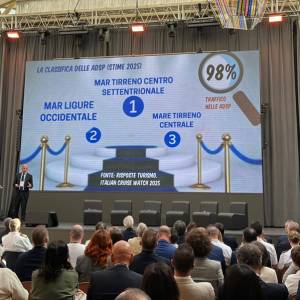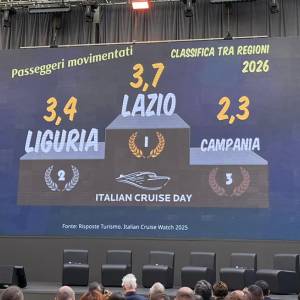
“The cruise industry is at the heart of the blue economy, in terms of technological innovation and research, as Formula 1 is to the car industry”.
Declared the President of the Western Ligurian Sea Port Authority Matteo Paroli at the 12th edition of the annual Italian Cruise Day, organised by Risposte e Turismo in Catania. Invited as panel speaker, Paroli highlighted the strategic role of Genoa and Savona as second-ranking Italian cruise port and as one of the top cruising areas in the Mediterranean. With an average yearly passenger throughput of 2.2 million, and a 4% increase registered in the first eight months of 2025 on the corresponding period of 2024, in line with the overall growth rates announced by Francesco di Cesare during the presentation of the market study, the Port Authority President linked the strong performance of the Ligurian ports to the close cooperation between all the local industry stakeholders, specifically, the terminal operating companies, Stazioni Marittime Genova and Palacrociere Savona.
Alongside the new opportunities offered by the expanding cruise market, there are new challenges which must be addressed, above all in reconciling an upgrade in infrastructure and services with environmental sustainability and integration with the surrounding urban fabric.
In terms of infrastructure, investments are underway to promote the use of railway services on the part of cruise passengers, today deployed by only 8% of the total. Within this framework, 5 million euros have been allocated to the renovation of a barrier-free underground pedestrian route connecting Piazza Principe International Railway Station directly to the cruise terminal, with access to the quayline via a new high-capacity lift. In addition, plans are afoot to build a moving walkway between Genova City Airport and a new dedicated mainline railway station, offering incoming passengers the opportunity to reach the city centre and Stazioni Marittime Cruise Terminal in just 10 minutes via a shuttle rail link.
Furthermore, in a significant stride towards environmental sustainability, the Western Ligurian Sea Port Authority is investing a total of 52 million euros in the provision of onshore power supply to cruise and ferry ships calling at the Ports of Genoa, scheduled for completion in 2026. By enabling vessels to switch off their generators and connect to the electrical power grid while docked, OPS promises an immediate reduction in carbon emissions and noise pollution.
Since May 2025, the Mediterranean has been designated a Sulphur Emission Control Area (SECA), established under the IMO MARPOL Convention, whereby ships within the port radius must switch to fuels with a sulphur content of a maximum of 0.10%. Since cruise lines overall are investing heavily in the clean energy transition, investments are also underway to accommodate a new LNG coastal facility in Savona by the forthcoming year, another example of successful ongoing public/private forms of cooperation.
In addition, innovative solutions tested on cruise ships, - including seawater purification systems, onboard waste recycling to generate energy, advanced marine coatings to improve hydrodynamic efficiency – are impacting the shipping industry across the board. The cruise industry has definitely emerged forcefully as the testing ground for research and technological innovation in the global maritime sector.






